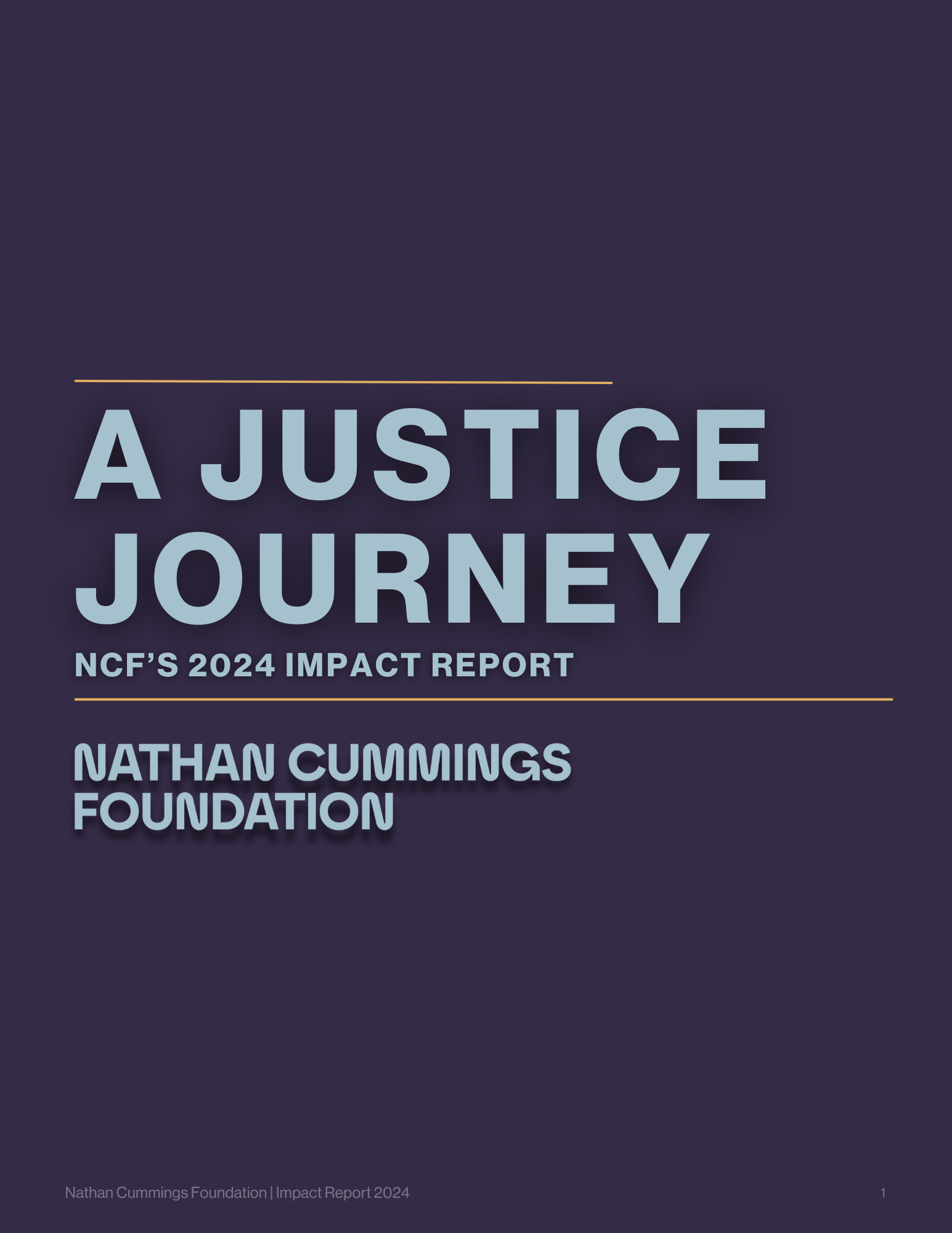President’s Remarks: Confluence Philanthropy’s 9th Annual Practitioners Gathering
Morning Introduction by Sharon Alpert, President and CEO, Nathan Cummings Foundation
Good morning. My name is Sharon Alpert, and I’m the president and CEO of the Nathan Cummings Foundation. Thank you to Dana Lanza and the entire Confluence team. It’s truly been a pleasure and an inspiration to be here in this community with all of you these last few days.
It is hard to believe that just one year ago, here at Confluence, we announced our Board’s unanimous decision to align 100 percent of our nearly half-billion-dollar endowment to advance our mission, which in our case is to build a more just, vibrant, sustainable, and democratic society. We recognized that the problems we are working on – the climate crisis and growing inequality – will not be solved by grantmaking alone. Capital markets have to change to drive sustainable and inclusive growth that will create long-term value for people, the planet, and the economy.
We made the decision because we believe that philanthropy should be using all of our resources to drive change. And this has led us to think deeply about our business model. We are in the business of changemaking, not just grantmaking, and we have a much wider set of tools to do that.
We are so grateful for the support and interest we’ve received from many of you in this room. I am more convinced than ever that this was the right decision and that we need more capital to move in this direction. That doesn’t mean it’s easy.
So, as many of you have asked, why hasn’t more capital moved? What will it take?
With you, we are part of a growing movement that is questioning and challenging some so-called “truths” we have been told about our capital markets and the potential of impact investing.
These create real barriers to progress.
Powerful forces continue to sell these “truths” – but we don’t have to buy them.
Today I want to focus on three of these “truths” and what we’re learning and doing about them as part of our commitment to 100-percent alignment.
- Businesses exist primarily to maximize profit for their shareholders.
- It is a “cost” for businesses to consider the long-term sustainability of their practices, from an environmental, social, or governance standpoint.
- Investing in line with your values or investing to do good creates financial risk or is at odds with your fiduciary role.
We reject the premise of shareholder primacy – that the highest calling of our business leaders is to generate a profit at nearly any cost, and all other considerations, for the environment, for workers, for society, are secondary, if they are considered at all.
Corporations in this country were initially envisioned as existing to serve the needs of society.
Despite being deemed people by the Supreme Court, we know that corporations do not exist in the absence of a set of rules that we, the actual people, have created.
Their right to exist is not fundamental or a given, but something we permit.
We also reject the so-called “truth” that low prices, and no other public interest concerns, are – and have long been – the only thing that matters. The consumer welfare standard, which is the driving force behind current interpretations of antitrust law, is a relatively new way of thinking. It rose to dominance beginning in the late 1970s. In the past, this country has explicitly recognized that corporate concentration and monopoly power were bad things. They not only harmed competition and innovation, small businesses and workers, but also endangered our very democracy.
Their broad-based acceptance has played no small part in allowing vast amounts of wealth and power to accrue to a narrow slice of economic and political elites while ordinary people face stagnating wages and a climate crisis.
If we really want to change the status quo, like we say we’re here to do, we need to stop “buying” these ways of thinking about how markets and corporations should be governed and who should benefit from us sitting on the sidelines and not using our power to change the rules of the game.
We reject this “playbook” because we know the results it produces.
As the panel on democratizing finance discussed yesterday, the inequality we have in the system was not fated to be. It was a consequence of deliberate decisions that were made along the way.
Women launched more than 1,800 new businesses every day in the U.S., according to the 2018 State of Women-Owned Businesses Report, commissioned by American Express.
And, over the past decade, eight out of 10 were women of color. (In fact, women-owned businesses now employ more than 9 million people and generate $1.8 trillion in annual revenue.)
And yet, diverse founders receive a tiny fraction of venture capital. All-women teams received just $1.9 billion of the $85 billion total invested by venture capitalists last year. That’s equal to about 2.2 percent. Meanwhile, all-male teams received about $66.9 billion—roughly 79 percent.
My fellow economists call this a market inefficiency, and estimates say that it costs us 9 million jobs and $300 billion in revenue each year.
Questioning the “playbook” has led us to redeploy capital to more aligned funds.
We are now asking for diversity and inclusion metrics from our OCIO for all our investments. Right now, more than 20 percent of our investment funds are owned by women or people of color. That compares well to an industry average of 3 to 9 percent, but still leaves much room for improvement.
We believe that, by supporting the next generation of diverse fund managers, we can both restore capital to underserved communities and participate in exciting new opportunities that traditional capital markets have overlooked.
In the last year, we moved another 40 million to aligned investments.
Let me give you an example.
Through our partnership with Precursor Ventures, we invested in Goodr, a food waste management company that uses innovative technology and works with logistics groups to pick up surplus edible food and get it to folks who need it.
Seventy-two billion pounds of edible food is wasted each year, which is a significant contributor to environmental damage and carbon emissions at every stage from production to landfill. More than 42 million people in the U.S. face food insecurity each day.
And, just as importantly, Precursor is led by people of color, and Goodr is owned by a woman of color.
Goodr is just one example of what’s possible when an entrepreneur integrates social good into her business strategy.
We do not think it is a “cost” for businesses to consider the materiality of environmental, social, or governance issues.
A recent meta-study (a study of over 2,000 other studies!) found a positive correlation between ESG and financial performance in 60 percent of the studies they examined.
McKinsey has shown that companies with diverse leadership teams are 33 percent more likely to outperform their peers.
However, there are significant costs involved in ignoring these issues.
One need only to think of examples like the recent bankruptcy of PG&E, which Forbes and The Wall Street Journal both noted was the first climate change bankruptcy we’ve seen, but almost certainly not the last.
Last night we heard Amy Goodman recount her experience at Standing Rock, lifting up the power of people we saw unleashed as a result of the unprecedented organizing by tribal communities and indigenous leaders, some of whom we are lucky to have in the room today. I have to give a shout out to one of our partners, Carla Fredericks and the First Peoples Investment Engagement Program, where Chairman Dave Archimbault is now a fellow.
They recently published a study about ETP, the company that built the Dakota Access Pipeline. Its stock declined in value by almost 20 percent from 2016 to 2018, whereas the S&P 500 increased in value by nearly 35 percent. The study also found that costs incurred by ETP and other firms with ownership stake in DAPL for the entire project amounted to at least $7.5 billion—double the original projected cost of $3.2 billion. Not accounting for social risks has material financial consequences, and it certainly did for the investors in ETP.
Looking at our investments through an ESG lens doesn’t jeopardize our fiduciary role; it strengthens it.
And that brings me to my last point, which is really a call to action for everyone in this room. It is our responsibility to use our power as investors to change corporate behavior – a tool that is still vastly underutilized in philanthropy and now under threat from groups like the Main Street Investors Coalition who certainly don’t underestimate its potential.
The Nathan Cummings Foundation has filed more than two hundred shareholder proposals over the last decade, alongside leaders like Walden Asset Management, Interfaith Center on Corporate Responsibility, and As You Sow. We are calling attention to problematic practices and ultimately changing behavior on issues ranging from board diversity, disclosure of political spending by energy companies lobbying against climate policies, to hate speech, and workers’ rights.
Prompted in part by our engagements focused on mass incarceration, led by our partners at ICCR – JP Morgan, just this week announced that it will no longer finance private prisons and immigrant detention centers.
Also prompted partly by our engagement, Southern Company, one of the largest GHG emitters in the U.S., has established a goal of low-to-no emissions by 2050. In partnership with our grantee, the Climate Majority Project, and other institutional investors, we’re working to push not just Southern, but all utilities, to link executive compensation to progress on GHG emissions reduction goals.
This year, we’re undertaking work to push 10 female-focused and brand dependent companies to exclude harassment and discrimination claims from binding arbitration.
Investors aren’t the only ones that recognize the power of shareholder engagement. We’re increasingly seeing workers turn to this strategy. In the private equity space, we’ve seen investors and workers combine forces to win concessions from Bain and KKR following the Toys “R” Us bankruptcy. Google employees partnered with ICCR member Zevin Asset Management on a shareholder proposal asking Alphabet, Google’s parent company, to tie executive compensation to progress on key social risks facing the company, including employee diversity and the displacement of local residents where the company buys real estate.
We think there’s tremendous potential in the power of combining worker pressure with investor pressure.
When we say use all of our resources towards our mission, this is a huge lever for us and one where we have seen measurable results in changing corporate behavior and influencing capital markets.
As we get ready to listen to Edgar and Anand, both of whom I know will have no problem challenging us to confront some hard truths and whom I am excited to hear, I will leave you with this:
- We can have a market that works for all of us, instead of just a few.
- We can have a playbook that serves the needs of the people, instead of powerful corporations.
- We can halt the climate crisis and create an inclusive clean economy that builds wealth for those who have been left out of the dirty one.
These are our truths, and with the full resources of our endowment, that is what we are buying.
Thank you.
Learn more about Confluence Philanthropy’s Annual Practitioners Gathering: http://www.confluencegathering.org

